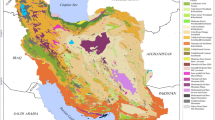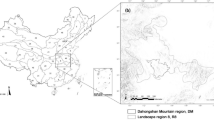Abstract
Five local ecological types based on vegetative communities and two landscape types based on groups of communities, were identified by integrating landform, soil, and vegetation components using multivariate techniques. Elevation and several topographic and soil variables were highly correlated with types of both scales. Landscape ecological types based only on landform and soil variables without vegetation did not correspond with types developed using vegetation. Models developed from these relationships could allow classification and mapping of extensive areas using geographic information systems.
Similar content being viewed by others
References
BaileyR.G.: 1988, ‘Ecogeographic analysis’, Miscellaneous Publication No. 1465, US Dep. Agric., For. Serv., Washington, DC, 16 pp.
BraunE.L.: 1950, Deciduous Forests of Eastern North America, The Blakiston Company, Philadelphia, Pensylvannia, 296 pp.
DavisJ.H.Jr.: 1930, ‘Vegetation of the Black Mountains of North Carolina: an ecological study’, Journal of Elisha Mitchell Scientific Society 45, 291–318.
GoldenM.S.: 1981, ‘An integrated multivariate analysis of forest communities of the central Great Smoky Mountains’, American Midland Naturalist 106(1), 37–53.
HackJ.T.: 1982, ‘Physiographic divisions and differential uplift in the Piedmont and Blue Ridge’, Geological Survey Professional Paper No. 1265, US Dep. Inter. Geol. Survey, Washington, DC, 49 pp.
HadleyJ.B. and NelsonA.E.: 1971, Geologic map of the Knoxville quadrangle, North Carolina, Tennessee and South Carolina, Map I-654 at 1:250 000 scale, US Geol. Survey, Miscellaneous Geologic Investigations, Washington, DC.
LandisJ.R. and KochG.C.: 1977, ‘The measurement of observer agreement for categorical data’, Biometrics 33, 159–174.
McLeod, D.E.: 1988, ‘Vegetation patterns, floristics and environmental relationships in the Black and Craggy Mountains of North Carolina’, Ph.D. dissertation, University of North Carolina, Chapel Hill, North Carolina, 222 pp.
McNabW.H.: 1991, ‘Predicting forest type in Bent Creek Experimental Forest from topographic variables’, In: S.S.Coleman and D.G.Neary (eds.), Proceedings of the Sixth Biennial Southern Silvicultural Research Conference, Vol. 1, 1990 Oct. 30–Nov. 1, Memphis, Tennessee, Gen. Tech. Rep. SE-70, US Dep. Agric., For. Serv., Asheville, North Carolina, pp. 496–504.
Tennessee Valley Authority: 1979, Climatic data base Blue Ridge/Zone I, Asheville, North Carolina’, Tennessee Valley Authority, Knoxville, Tennessee, 28 pp.
USDA Forest Service: (Unpubl.) Soil survey of Bent Creek Experimental Forest’, On file with: US Dep. Agric., For. Serv., Asheville, North Carolina, 28806, 32 pp.
WhittakerR.H.: 1956, ‘Vegetation of the Great Smoky Mountains’, Ecological Monographs 26(1), 1–80.
ZonR.: 1908, ‘Principles involved in determining forest types’, Forest Quarterly 6, 262–271.
Author information
Authors and Affiliations
Rights and permissions
About this article
Cite this article
McNab, W.H. Classification of local- and landscape-scale ecological types in the southern Appalachian Mountains. Environ Monit Assess 39, 215–229 (1996). https://doi.org/10.1007/BF00396146
Issue Date:
DOI: https://doi.org/10.1007/BF00396146




